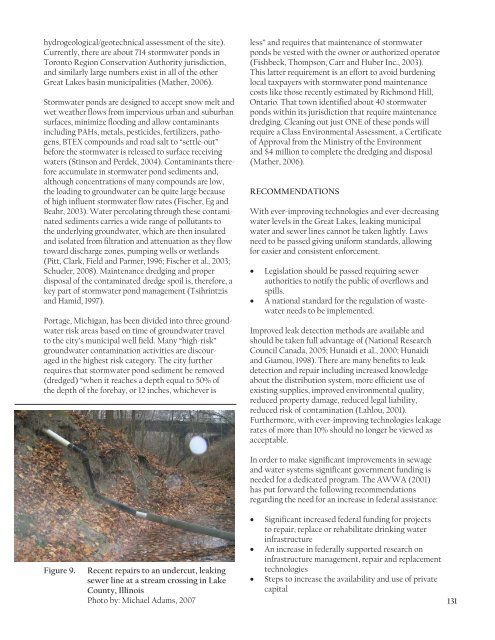Groundwater in the Great Lakes Basin
Groundwater in the Great Lakes Basin
Groundwater in the Great Lakes Basin
Create successful ePaper yourself
Turn your PDF publications into a flip-book with our unique Google optimized e-Paper software.
hydrogeological/geotechnical assessment of <strong>the</strong> site).<br />
Currently, <strong>the</strong>re are about 714 stormwater ponds <strong>in</strong><br />
Toronto Region Conservation Authority jurisdiction,<br />
and similarly large numbers exist <strong>in</strong> all of <strong>the</strong> o<strong>the</strong>r<br />
<strong>Great</strong> <strong>Lakes</strong> bas<strong>in</strong> municipalities (Ma<strong>the</strong>r, 2006).<br />
Stormwater ponds are designed to accept snow melt and<br />
wet wea<strong>the</strong>r flows from impervious urban and suburban<br />
surfaces, m<strong>in</strong>imize flood<strong>in</strong>g and allow contam<strong>in</strong>ants<br />
<strong>in</strong>clud<strong>in</strong>g PAHs, metals, pesticides, fertilizers, pathogens,<br />
BTEX compounds and road salt to “settle-out”<br />
before <strong>the</strong> stormwater is released to surface receiv<strong>in</strong>g<br />
waters (St<strong>in</strong>son and Perdek, 2004). Contam<strong>in</strong>ants <strong>the</strong>refore<br />
accumulate <strong>in</strong> stormwater pond sediments and,<br />
although concentrations of many compounds are low,<br />
<strong>the</strong> load<strong>in</strong>g to groundwater can be quite large because<br />
of high <strong>in</strong>fluent stormwater flow rates (Fischer, Eg and<br />
Beahr, 2003). Water percolat<strong>in</strong>g through <strong>the</strong>se contam<strong>in</strong>ated<br />
sediments carries a wide range of pollutants to<br />
<strong>the</strong> underly<strong>in</strong>g groundwater, which are <strong>the</strong>n <strong>in</strong>sulated<br />
and isolated from filtration and attenuation as <strong>the</strong>y flow<br />
toward discharge zones, pump<strong>in</strong>g wells or wetlands<br />
(Pitt, Clark, Field and Parmer, 1996; Fischer et al., 2003;<br />
Schueler, 2008). Ma<strong>in</strong>tenance dredg<strong>in</strong>g and proper<br />
disposal of <strong>the</strong> contam<strong>in</strong>ated dredge spoil is, <strong>the</strong>refore, a<br />
key part of stormwater pond management (Tsihr<strong>in</strong>tzis<br />
and Hamid, 1997).<br />
Portage, Michigan, has been divided <strong>in</strong>to three groundwater<br />
risk areas based on time of groundwater travel<br />
to <strong>the</strong> city’s municipal well field. Many “high-risk”<br />
groundwater contam<strong>in</strong>ation activities are discouraged<br />
<strong>in</strong> <strong>the</strong> highest risk category. The city fur<strong>the</strong>r<br />
requires that stormwater pond sediment be removed<br />
(dredged) “when it reaches a depth equal to 50% of<br />
<strong>the</strong> depth of <strong>the</strong> forebay, or 12 <strong>in</strong>ches, whichever is<br />
less” and requires that ma<strong>in</strong>tenance of stormwater<br />
ponds be vested with <strong>the</strong> owner or authorized operator<br />
(Fishbeck, Thompson, Carr and Huber Inc., 2003).<br />
This latter requirement is an effort to avoid burden<strong>in</strong>g<br />
local taxpayers with stormwater pond ma<strong>in</strong>tenance<br />
costs like those recently estimated by Richmond Hill,<br />
Ontario. That town identified about 40 stormwater<br />
ponds with<strong>in</strong> its jurisdiction that require ma<strong>in</strong>tenance<br />
dredg<strong>in</strong>g. Clean<strong>in</strong>g out just ONE of <strong>the</strong>se ponds will<br />
require a Class Environmental Assessment, a Certificate<br />
of Approval from <strong>the</strong> M<strong>in</strong>istry of <strong>the</strong> Environment<br />
and $4 million to complete <strong>the</strong> dredg<strong>in</strong>g and disposal<br />
(Ma<strong>the</strong>r, 2006).<br />
Recommendations<br />
With ever-improv<strong>in</strong>g technologies and ever-decreas<strong>in</strong>g<br />
water levels <strong>in</strong> <strong>the</strong> <strong>Great</strong> <strong>Lakes</strong>, leak<strong>in</strong>g municipal<br />
water and sewer l<strong>in</strong>es cannot be taken lightly. Laws<br />
need to be passed giv<strong>in</strong>g uniform standards, allow<strong>in</strong>g<br />
for easier and consistent enforcement.<br />
• Legislation should be passed requir<strong>in</strong>g sewer<br />
authorities to notify <strong>the</strong> public of overflows and<br />
spills.<br />
• A national standard for <strong>the</strong> regulation of wastewater<br />
needs to be implemented.<br />
Improved leak detection methods are available and<br />
should be taken full advantage of (National Research<br />
Council Canada, 2005; Hunaidi et al., 2000; Hunaidi<br />
and Giamou, 1998). There are many benefits to leak<br />
detection and repair <strong>in</strong>clud<strong>in</strong>g <strong>in</strong>creased knowledge<br />
about <strong>the</strong> distribution system, more efficient use of<br />
exist<strong>in</strong>g supplies, improved environmental quality,<br />
reduced property damage, reduced legal liability,<br />
reduced risk of contam<strong>in</strong>ation (Lahlou, 2001).<br />
Fur<strong>the</strong>rmore, with ever-improv<strong>in</strong>g technologies leakage<br />
rates of more than 10% should no longer be viewed as<br />
acceptable.<br />
Figure 9.<br />
Recent repairs to an undercut, leak<strong>in</strong>g<br />
sewer l<strong>in</strong>e at a stream cross<strong>in</strong>g <strong>in</strong> Lake<br />
County, Ill<strong>in</strong>ois<br />
Photo by: Michael Adams, 2007<br />
In order to make significant improvements <strong>in</strong> sewage<br />
and water systems significant government fund<strong>in</strong>g is<br />
needed for a dedicated program. The AWWA (2001)<br />
has put forward <strong>the</strong> follow<strong>in</strong>g recommendations<br />
regard<strong>in</strong>g <strong>the</strong> need for an <strong>in</strong>crease <strong>in</strong> federal assistance:<br />
• Significant <strong>in</strong>creased federal fund<strong>in</strong>g for projects<br />
to repair, replace or rehabilitate dr<strong>in</strong>k<strong>in</strong>g water<br />
<strong>in</strong>frastructure<br />
• An <strong>in</strong>crease <strong>in</strong> federally supported research on<br />
<strong>in</strong>frastructure management, repair and replacement<br />
technologies<br />
• Steps to <strong>in</strong>crease <strong>the</strong> availability and use of private<br />
capital<br />
131

















